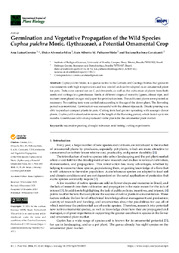Germination and vegetative propagation of the wild species cuphea pulchra moric. (Lythraceae), a potential ornamental crop.
Germination and vegetative propagation of the wild species cuphea pulchra moric. (Lythraceae), a potential ornamental crop.
Author(s): CORSINO, A. L.; SILVA, D. A. da; MELO, L. A. M. P. de; CAVALCANTI, T. B.
Summary: Cuphea pulchra Moric. is a species native to the Cerrado and Caatinga biomes that grows in environments with high temperatures and low rainfall and can be adapted as an ornamental plant for pots. Tests were carried out on C. pulchra seeds, as well as the cultivation of plants from both seeds and cuttings in a greenhouse. Seeds at different stages of maturity (green, almost ripe, and mature) were placed on agar and paper for germination tests. The cultivated plants were pruned as necessary. Two cutting tests were carried out according to the age of the donor plant. The flowering period was monitored. Germination was successful with the almost ripe seeds. Drastic pruning was able to produce compact plants in pots. Cutting tests had greater sprouting with younger donor plants. Cuphea pulchra stood out in terms of the length of the flowering period, which lasted up to ten months. Greenhouse cultivation produced viable plants for the ornamental plant market.
Publication year: 2024
Types of publication: Journal article
Keywords: Cutting, Drought tolerance, Pruning, Seeds, Testing
Observation
Some of Embrapa's publications are published as ePub files. To read them, use or download one of the following free software options to your computer or mobile device. Android: Google Play Books; IOS: iBooks; Windows and Linux: Calibre.
Access other publications
Access the Agricultural Research Database (BDPA) to consult Embrapa's full library collection and records.
Visit Embrapa Bookstore to purchase books and other publications sold by Embrapa.

